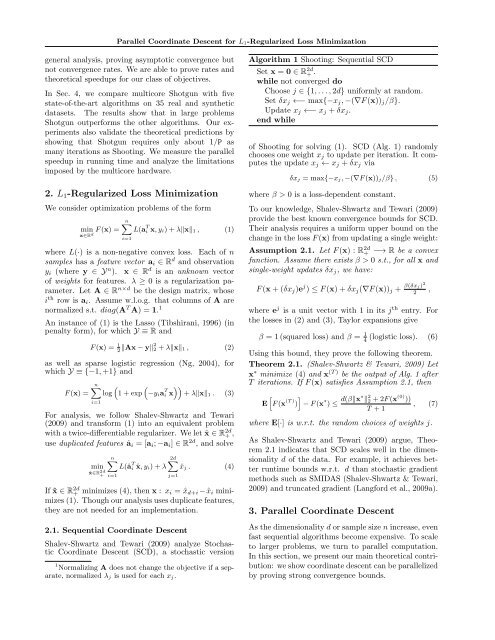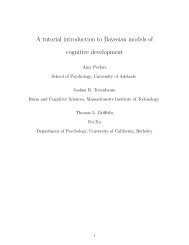Parallel Coordinate Descent for L1-Regularized Loss Minimization
Parallel Coordinate Descent for L1-Regularized Loss Minimization
Parallel Coordinate Descent for L1-Regularized Loss Minimization
Create successful ePaper yourself
Turn your PDF publications into a flip-book with our unique Google optimized e-Paper software.
<strong>Parallel</strong> <strong>Coordinate</strong> <strong>Descent</strong> <strong>for</strong> L 1-<strong>Regularized</strong> <strong>Loss</strong> <strong>Minimization</strong><br />
general analysis, proving asymptotic convergence but<br />
not convergence rates. We are able to prove rates and<br />
theoretical speedups <strong>for</strong> our class of objectives.<br />
In Sec. 4, we compare multicore Shotgun with five<br />
state-of-the-art algorithms on 35 real and synthetic<br />
datasets. The results show that in large problems<br />
Shotgun outper<strong>for</strong>ms the other algorithms. Our experiments<br />
also validate the theoretical predictions by<br />
showing that Shotgun requires only about 1/P as<br />
many iterations as Shooting. We measure the parallel<br />
speedup in running time and analyze the limitations<br />
imposed by the multicore hardware.<br />
2. L 1 -<strong>Regularized</strong> <strong>Loss</strong> <strong>Minimization</strong><br />
We consider optimization problems of the <strong>for</strong>m<br />
min F (x) =<br />
x∈R d<br />
n<br />
∑<br />
i=1<br />
L(a T i x, y i) + λ‖x‖ 1 , (1)<br />
where L(·) is a non-negative convex loss. Each of n<br />
samples has a feature vector a i ∈ R d and observation<br />
y i (where y ∈ Y n ). x ∈ R d is an unknown vector<br />
of weights <strong>for</strong> features. λ ≥ 0 is a regularization parameter.<br />
Let A ∈ R n×d be the design matrix, whose<br />
i th row is a i . Assume w.l.o.g. that columns of A are<br />
normalized s.t. diag(A T A) = 1. 1<br />
An instance of (1) is the Lasso (Tibshirani, 1996) (in<br />
penalty <strong>for</strong>m), <strong>for</strong> which Y ≡ R and<br />
F (x) = 1 2 ‖Ax − y‖2 2 + λ‖x‖ 1 , (2)<br />
as well as sparse logistic regression (Ng, 2004), <strong>for</strong><br />
which Y ≡ {−1, +1} and<br />
F (x) =<br />
n∑<br />
i=1<br />
( ( ))<br />
log 1 + exp −y ia T i x + λ‖x‖ 1 . (3)<br />
For analysis, we follow Shalev-Shwartz and Tewari<br />
(2009) and trans<strong>for</strong>m (1) into an equivalent problem<br />
with a twice-differentiable regularizer. We let ˆx ∈ R 2d<br />
+ ,<br />
use duplicated features â i = [a i ; −a i ] ∈ R 2d , and solve<br />
min<br />
ˆx∈R 2d<br />
+<br />
n∑<br />
L(â T i ˆx, y i) + λ<br />
i=1<br />
2d∑<br />
j=1<br />
ˆx j . (4)<br />
If ˆx ∈ R 2d<br />
+ minimizes (4), then x : x i = ˆx d+i − ˆx i minimizes<br />
(1). Though our analysis uses duplicate features,<br />
they are not needed <strong>for</strong> an implementation.<br />
2.1. Sequential <strong>Coordinate</strong> <strong>Descent</strong><br />
Shalev-Shwartz and Tewari (2009) analyze Stochastic<br />
<strong>Coordinate</strong> <strong>Descent</strong> (SCD), a stochastic version<br />
1 Normalizing A does not change the objective if a separate,<br />
normalized λ j is used <strong>for</strong> each x j.<br />
Algorithm 1 Shooting: Sequential SCD<br />
Set x = 0 ∈ R 2d<br />
+ .<br />
while not converged do<br />
Choose j ∈ {1, . . . , 2d} uni<strong>for</strong>mly at random.<br />
Set δx j ←− max{−x j , −(∇F (x)) j /β}.<br />
Update x j ←− x j + δx j .<br />
end while<br />
of Shooting <strong>for</strong> solving (1). SCD (Alg. 1) randomly<br />
chooses one weight x j to update per iteration. It computes<br />
the update x j ← x j + δx j via<br />
δx j = max{−x j, −(∇F (x)) j/β} , (5)<br />
where β > 0 is a loss-dependent constant.<br />
To our knowledge, Shalev-Shwartz and Tewari (2009)<br />
provide the best known convergence bounds <strong>for</strong> SCD.<br />
Their analysis requires a uni<strong>for</strong>m upper bound on the<br />
change in the loss F (x) from updating a single weight:<br />
Assumption 2.1. Let F (x) : R 2d<br />
+ −→ R be a convex<br />
function. Assume there exists β > 0 s.t., <strong>for</strong> all x and<br />
single-weight updates δx j , we have:<br />
F (x + (δx j )e j ) ≤ F (x) + δx j (∇F (x)) j + β(δxj)2<br />
2<br />
,<br />
where e j is a unit vector with 1 in its j th entry. For<br />
the losses in (2) and (3), Taylor expansions give<br />
β = 1 (squared loss) and β = 1 4<br />
(logistic loss). (6)<br />
Using this bound, they prove the following theorem.<br />
Theorem 2.1. (Shalev-Shwartz & Tewari, 2009) Let<br />
x ∗ minimize (4) and x (T ) be the output of Alg. 1 after<br />
T iterations. If F (x) satisfies Assumption 2.1, then<br />
[ ]<br />
E F (x (T ) ) − F (x ∗ ) ≤ d(β‖x∗ ‖ 2 2 + 2F (x (0) ))<br />
, (7)<br />
T + 1<br />
where E[·] is w.r.t. the random choices of weights j.<br />
As Shalev-Shwartz and Tewari (2009) argue, Theorem<br />
2.1 indicates that SCD scales well in the dimensionality<br />
d of the data. For example, it achieves better<br />
runtime bounds w.r.t. d than stochastic gradient<br />
methods such as SMIDAS (Shalev-Shwartz & Tewari,<br />
2009) and truncated gradient (Lang<strong>for</strong>d et al., 2009a).<br />
3. <strong>Parallel</strong> <strong>Coordinate</strong> <strong>Descent</strong><br />
As the dimensionality d or sample size n increase, even<br />
fast sequential algorithms become expensive. To scale<br />
to larger problems, we turn to parallel computation.<br />
In this section, we present our main theoretical contribution:<br />
we show coordinate descent can be parallelized<br />
by proving strong convergence bounds.



